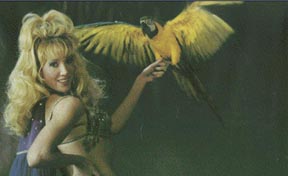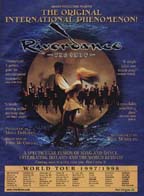



Gary Ouellet continued his astonishing run of televised magic specials with a May entry on CBS featuring a single magician, Melinda. The Little Egypt Gazette is pleased to take a closer look at this lady and her magic.
 |
|
Let's get my bias out in the open, right off. If an incredibly beautiful female magician not only wears, but does extraordinary justice to, a slit-up-the-side Jessica Rabbit dress, I'm going to like her television special. A lot. This confession out of the way, let's take a quick rundown of the show for those who missed it, and then on to a few observations. |
 Disney's Melinda: First Lady of Magic aired on CBS at 8:00, on Friday, May 30. Produced by Gary Ouellet and Stephen Zandrick, the television special was a fast concoction of dance and illusion and costume changes, beginning with the roar of a motorcycle and climaxing nearly an hour later with a race car revved up to "180 miles per hour." And so we begin . . . The Motorcycle Vanish -- In a tight black body suit, Melinda opens with the vanish of herself on a motorcycle, with our girl reappearing from an empty box. Appraisal: "she" was too far away from the camera when the rider and bike vanished for this to be effective on tv. In addition, I don't think straightforward black art vanishes fool anyone. It's nevertheless an upbeat opener that gets the show off to an energetic start. (Melinda has outgrown, especially in this Disney context, the bump and grind opening sequence she featured years ago on stage and on her Dick Clark Presents appearance, in which her black outfit vanished, via a full light seance gimmick, to reveal her in a shiny string bikini. There is a world beyond Las Vegas, and times change, but that opener remains one of the most memorable openers to a magic act I've seen.) Opening Chat -- Gorgeous in a black strapless evening gown, Melinda introduces the fact that the show will be framed as "weaving my magic with a special story about a little girl who has a big imagination." The little girl is Kelsey Mulrooney, who with her screen mom, Shelley Long, dreams up a female magician named Melinda. I found this a challenging premise -- that a famous female magician can exist only in a little girl's imagination. The Winged Horse Vanish -- Melinda rides into Kelsey's fantasy on a winged white horse, and the horse vanishes. Again, I don't find black art vanishes believable. Roy Horn also uses black art to vanish himself and steed, on the Mirage stage, and it doesn't work for him either. But I've always liked Melinda's entrance on that horse, as well as Roy's (a better rider, he compels his horse to dance). In each case, the horse is a beautiful accessory in search of a stronger illusion in which to use it. Melinda Meets Her Prince -- One of the strongest illusion sequences and one of the most Copperfield-esque. It's a sexy, romantic number in which Melinda turns a cleaning maid into her boyfriend, and later back into the cleaning lady. Both exchanges were fast and startling, and Melinda looked lovely for this segment in an extremely short blue dress. (I immediately thought of it as her Becker dress, as it threatened to expose all her secrets.) The Honeymoon Prediction -- In the black evening gown, Melinda flirts with a fellow from the audience whom she has lured on stage to participate in a prediction of where and how she and the guy will spend their honeymoon. Such a segment (flirtation) has always been a part of Melinda's stage show, often via the context of a guillotine illusion. The Redcoats Are Coming -- In a red Revolutionary War jacket, and with great legs, Melinda dances her way through a piece that includes a cannon ball zombie, a dove production and vanish, and Melinda being shot from a cannon. Zombie is of course out of fashion in magic circles, but I still recall a day in junior high when I had inadvertently missed the Neil Foster episode of Don Alan's Magic Ranch. "They had this guy," my buddies said, "and he had a floating ball that floated all around his arms. It was really neat. It must have cost $10,000." In one unusual move, Melinda bent backwards toward the audience and let the ball float across her chest. I'd like to have seen Neil Foster do that. More on the cannon trick below. Sword Suspension -- In the black body suit, Melinda announces an illusion with a gender switch. Following some more dancing, she hypnotizes a male dancer and uses him as the "victim" or subject in the classic sword suspension illusion. Very nicely done. Asrah and More -- Magicians familiar with Melinda's stage show know this one as her "Phantom" illusion, because she used to perform it to Phantom of the Opera music. It's a switch illusion, in which Melinda is hypnotized by a witch and levitated via Asrah. When she vanishes in mid-air, the witch suddenly turns out to be Melinda. Roger Rabbit and Company -- Melinda is billed as Disney's Melinda for this special, and this extended segment exhibits the most overt Disney influence. Various Disney characters are eliminated in a touch screen effect, which homes in at last -- as predicted! -- on Cruella de Vil. Cruella is vanished from a large (really large) cloth, to be replaced by Roger Rabbit in an airplane. Whew! As impressive as the production of an airplane and a popular cartoon character might be, the magic in this playlet paled next to the sight of Melinda, with her hair straight, wearing the red dress once worn by Jessica Rabbit, the toon femme fatale from Who Framed Roger Rabbit. Wahoo. Roger Ebert describes Roger Rabbit's curvaceous wife as "the improbably pneumatic" Jessica, and the same might be said of Melinda. Three dimensions, amply filled out by Melinda, are far more impressive than Jessica's two. The Drill of Death -- This is the industrial strength version of Impaled that was the surprise hit of World's Greatest Magic II, with all the sparks and grinding gears of its original television premiere. Melinda casts this illusion as being "about not giving up -- even when things seem hopeless." It's one of my favorite illusions, alongside Copperfield's Death Saw and Lance's original dual levitation and the Pendragons' Metamorphosis. Melinda looks vulnerable and terrific in this one, and my only disappointment is that it didn't have, from the WGM II version, (a) the suspense of wondering if she would fall out of her costume and (b) the kittenish pose at the finish.
Al Unser Vanishes -- Yes, Al Unser, in a race car chained to a table (the car, not Al), vanishes, even though the vehicle is surrounded by spectators from the audience (who walk to the stage like hypnotized converts at a tent revival). Am I watching a Melinda special or a D.C. special? Ah, at least we're watching the one who looks best in black leather. I've no idea how this works, but have been conditioned to be highly suspicious of any produced or vanished object being surrounded by audience members. The coolest scripting of the show: Melinda breaks all the rules and never brings Al back! Perhaps she requires a second special to pull that off. Twin Levitation -- As the show, and its dreamlike metaphor, closes, Melinda causes a sleeping Kelsey Mulrooney to float off the bed. In order to pass a hoop over the child conveniently, Melinda herself rises into the air. |
Melinda received early magical grounding from the likes of Gary Darwin and Geno Munari and Jimmy Grippo, and her stage magic has been audience tested for years. Could Melinda's magic have been stronger in this television special? Yes, in places. As mentioned above,
black art is weak methodology unless you are Omar Pasha. I've also seen a couple of Melinda's
switch illusions (the shot-from-cannon routine and the Asrah switch) play stronger on the
confines of a medium-sized stage than they played here on television. Television consumes
performance material at an alarming rate, and audiences are quickly becoming familiar with
most of the trends in modern illusions. It's difficult to pull off a switch illusion without tipping
that a switch is about to occur. (It's also difficult to misdirect a camera. Only a few magicians
have been truly successful in recent years with switches, the two that come to mind being
Lance Burton's gramophone illusion and Rudy Coby's Puppet Boy switch.) On the other hand, several of Melinda's illusions worked quite
well, including the sword suspension and the inimitable Drill of Death. As an illusionist,
Melinda shares the charisma and savvy of the best, including Siegfried and Roy and Lance
Burton and the Pendragons: she knows how to keep the focus on herself rather than on the boxes,
and she knows how to take credit for the magic. If you think what any of these performers do is
easy ("it's just box magic"), go watch a few amateur illusionists have a go at it. Melinda is a stunning blonde who more resembles the stereotype of a magician's
assistant than of a magician, only better looking. Her stage persona is indeed that of a cutesy blonde, to wit
she uses a twist on a Dolly Parton line, something about it taking years to get that ditzy and months
to get that blonde. One reader wrote that he found her "fluffy," and I couldn't help but think that
she had worked hard to be that fluffy. She intentionally conforms to the stereotype of the conventional
male fantasy. It is perhaps a less-than-pc stereotype. The modern American girl has a degree in engineering and opens her own doors and goes to the Olympics and wins the gold medal in basketball
and softball and soccer. I like this modern girl too, but you work with what
God gives you, and Melinda works with extraordinary physical assets, combined with a love of
dancing and magic. I easily buy into the fantasy she creates on stage, and judging from her success
many others do as well. (Her success of course is anything but stereotypical, as she continues to carve a lucrative niche in a male dominated business. As Cindy Crawford once said, roughly, "I'm CEO of a corporation whose chief product is Cindy Crawford.") While a couple of Melinda's stage illusions failed to translate to television
as well as, say, the Drill, her looks nevertheless translated fabulously. She proved to be remarkably photogenic, and the
camera adored her, from the full-body dance numbers to the close-up head shots. Is Melinda indeed the First Lady of Magic? An unqualified yes. Show business is a total package. It includes the entire look and personality and likability of the performer, and it includes and all the hard work and
rehearsals that make everything look easy. Through her assets and her hard work -- endless hours of dance
rehearsal, getting the magic right, doing two shows a night for six nights a week for years, and
never missing a show -- Melinda has achieved greater show business success than any female
magician in history and greater than all but a handful of male magicians. In a city known for
thousands of beautiful girls and thousands of dancers and some of the finest magicians on the
planet, her name is a household word. She's earned her bragging rights. A television special in cahoots with CBS and Disney only further extends the mark others will have to reach, male or female, to equal her accomplishments. I'm a longtime Melinda fan and enjoyed this special, but perhaps you aren't and didn't. No
problem! Here's your opportunity to share what you think of Melinda's first tv special. Just check
off your opinions on the following form and click the submit button. Only one click per reader,
please. Your opinions will be kept totally confidential.

 A lay friend asked after the show: "So what was with all the dancing?" As
mentioned at the top, David Blaine and Melinda emerge from two different worlds, the street
and the Las Vegas stage. The shows in which Melinda has headlined at the Landmark, the
Sands, and the Lady Luck have all been tight, fast-paced variety shows, including additional
performers such as juggler Anthony Gatto, comedic bolo twirlers Los Latin Cowboys, and
unicycle-riding basketball players the King Charles Troupe. These shows, originally produced and choreographed by
Melinda's mom, Bonnie Saxe, have also heavily featured dance numbers, common to Las Vegas
revues and Broadway musicals but somewhat unusual for the typical tv viewer's concept of a
"magic show." (Pure dance numbers are suddenly rising in popularity with the success of such
shows as Stomp and Riverdance (see poster at left), so in a way Melinda is on the cutting edge by landing a
television special that could easily have been billed as starring "dancer Melinda Saxe" as it was
"magician Melinda Saxe." Indeed, TV Guide hyped the show as "Melinda: First Lady of Magic
dances with her entourage of male assistants . . .") Although male magicians, from Doug
Henning to David Copperfield, have occasionally attempted to dance, Melinda is the first
magician since Peter Pit who actually can dance, and I enjoy this part of her show. Partly, she
simply looks great, but there is also a planned functionality. The dance routines enable her to
establish moods and scenes that create context for the illusions that follow. Dancing is as
integral to Melinda's magic as, say, buffoonery is to Tom Mullica's.
A lay friend asked after the show: "So what was with all the dancing?" As
mentioned at the top, David Blaine and Melinda emerge from two different worlds, the street
and the Las Vegas stage. The shows in which Melinda has headlined at the Landmark, the
Sands, and the Lady Luck have all been tight, fast-paced variety shows, including additional
performers such as juggler Anthony Gatto, comedic bolo twirlers Los Latin Cowboys, and
unicycle-riding basketball players the King Charles Troupe. These shows, originally produced and choreographed by
Melinda's mom, Bonnie Saxe, have also heavily featured dance numbers, common to Las Vegas
revues and Broadway musicals but somewhat unusual for the typical tv viewer's concept of a
"magic show." (Pure dance numbers are suddenly rising in popularity with the success of such
shows as Stomp and Riverdance (see poster at left), so in a way Melinda is on the cutting edge by landing a
television special that could easily have been billed as starring "dancer Melinda Saxe" as it was
"magician Melinda Saxe." Indeed, TV Guide hyped the show as "Melinda: First Lady of Magic
dances with her entourage of male assistants . . .") Although male magicians, from Doug
Henning to David Copperfield, have occasionally attempted to dance, Melinda is the first
magician since Peter Pit who actually can dance, and I enjoy this part of her show. Partly, she
simply looks great, but there is also a planned functionality. The dance routines enable her to
establish moods and scenes that create context for the illusions that follow. Dancing is as
integral to Melinda's magic as, say, buffoonery is to Tom Mullica's. 


